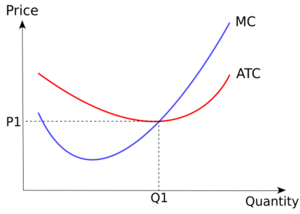Productive efficiency facts for kids
Productive efficiency is about using your resources in the best way possible. Imagine you have a limited amount of ingredients to bake cookies and cakes. If you are productively efficient, you are making the most cookies and cakes you can with those ingredients. You can't make more cookies without making fewer cakes, and vice versa. This means you're not wasting anything!
When an economy is productively efficient, it means it's making the most goods and services it can. It uses all its resources, like land, workers, and tools, without any waste. If a country finds new ways to produce things, like better technology, it can become even more efficient. This allows it to make more goods than before.
Productive inefficiency happens when resources are not used well. For example, if workers are sitting around doing nothing, or if machines are idle. If these resources could be used to make more things, then not using them is inefficient. It means the economy isn't reaching its full potential.
Allocative efficiency is a special kind of productive efficiency. It means producing the right amount of goods that people actually want and need. This helps society in the best way.
How We Show It
We can show productive efficiency using diagrams. Two common ways are the production possibility frontier (PPF) diagram and cost curves.
Production Possibility Frontier
Let's imagine an economy that only makes two things: guns and butter. The production possibility frontier (PPF) curve shows all the different combinations of guns and butter it can make. This is if it uses all its resources perfectly.
- Points like B, C, and D on the curve are productively efficient. At these points, the economy is using all its resources. It's impossible to make more guns without making less butter. The same is true for butter. For example, to make more butter (moving from D to C), you have to make fewer guns.
- If the economy is at point A, it's not using all its resources. It could make more guns and more butter without giving up anything. Moving from A to D means the economy is using its resources better.
- Point X is outside the curve. This point cannot be reached right now. The economy doesn't have enough resources to make that much.
Marginal and Average Total Cost
Businesses also aim for productive efficiency. For a business making a product, there are two important cost lines:
- The marginal cost (MC) is the extra cost to make one more item.
- The average total cost (ATC) is the average cost for each item made.
Look at the diagram. The MC line crosses the ATC line at its lowest point. This point is labeled P1 and Q1. This is the sweet spot for productive efficiency.
- At this point, the business is making the right amount (Q1) at the lowest possible average cost (P1).
- If the business makes less than Q1, it could still lower its average costs by making more.
- If it makes more than Q1, the extra cost of making one more item (MC) becomes higher than the average cost (ATC). This means it's becoming less efficient.
Some businesses might not try to be super efficient. This can happen if they are already making a lot of money. They might not feel the need to cut costs.
See also
 In Spanish: Eficiencia productiva para niños
In Spanish: Eficiencia productiva para niños



